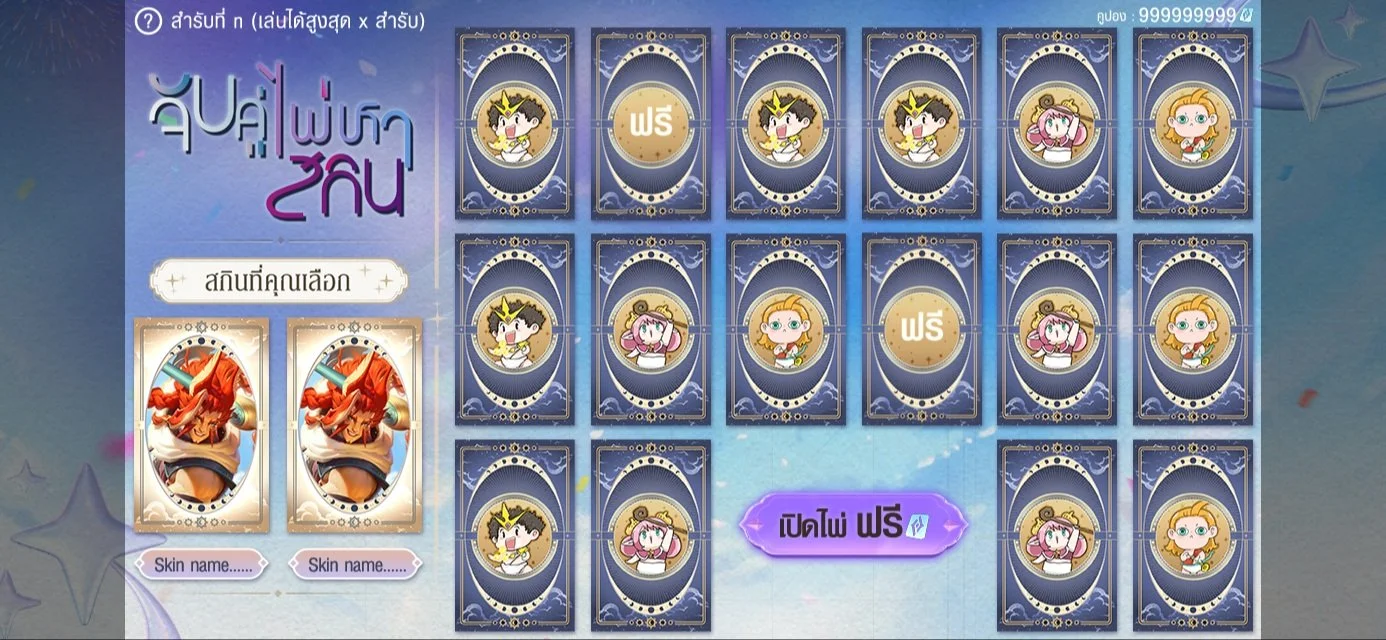
Matching Cards
In-Game Revenue Event
Overview:
An in-game revenue event that create from scratch. This is not a regular matching cards game. The code behind it allows the person in charge to control every possibility and determine on average how much a player needs to spend to win a reward.
Event Achievement:
The event will be re-launched every year as an annual event.
Attracted 99.8 % of active users* to visit the event.
Generates 42.6% Revenue*
* Compared with events in the same category.
Event Game Play: Youtube:(Link)
Story
During my internship at Garena, there was an ideas pool for new events that I was assigned to make, but I decided to propose my own idea. It was challenging because I had to ensure that I covered every single aspect of the event majority by myself: its appearance, functionality, expected revenue, maintenance of reward value, and more. However, with dedication, the company approved my event.
Events Details
In this game, players match cards with identical faces. Cards that have not been flipped will be labeled as "blank," allowing the system to determine their faces. However, once a player has flipped a card, it will retain the same face to make the player feel less randomness (gacha-like game) in the event. If a player unveils a non-matching card, it will return to a face-down position, and its face will not change when unveiled again.
-
This event aims to create a slot machine-like game that is easy to understand at first glance while shaping the event to give the impression that luck is a major influence, while still allowing other factors to affect the outcome.
This game is also very universal and can be adapted to servers in other regions, not just Thailand.
-
The revenue is based on the price of each card the player flipped, and the price will increase over time.
Goal: Set a low price in the beginning to attract players to the event. Then, gradually increase the price towards the end. Players will still be willing to pay the higher price as they will have already opened most of the cards and feel invested in the event.
-
There will be 16 cards in total (8 pairs) and divided into 3 tiers (T1-T3). The weight of dropping a rare reward can be adjusted by adjusting the rate of each flip.
(Follow the picture)
Event Userflow
Logos Draft & Typography
Problem and Solution:
Problem:
While I was designing this event, I created the layout to be more vertical (draft). I tested it on my own phone and on the company test phone, and it seemed to work well as the size wasn't too small. However, when I saw someone with a smaller screen size, it may create a bad experience for them because the content would appear very small.
Solution:
I decided to scrap the old layout and create a new one. Another major problem is that I can't reduce the number of cards because it will affect the revenue and the value of the reward (in the end, I created three versions of the layout with different numbers of cards), But for the 16 cards layout, I had to design it horizontally, which initially didn't fit the screen because the system required "dead space" where we couldn't populate any assets. Finally, I designed it with 4 cards surrounding the "flip" button, which has several benefits. First, each card can use up more space, making it easier for players with small screens to tap on the cards. This design also leaves unused areas around the flip button to fill the screen perfectly.
First Draft
Final Draft
Problem:
The main goal is to attract players with low prices and then gradually increase the prices over time and make sure the player still gets hooked. By making the player feel like there are only a few cards left, and let the game encourage them to finish. The question is what point will players still be willing to pay to flip the card?
I tried using other data from another similar event to help, but it didn't answer this question and there isn't enough time in my internship to conduct testing.
Solution:
When encountering an issue like this, a report analysis of the event result is a must. I also design a backup layout of the event and ensure major variables can be adjustable for future relaunches.
In this event, I make sure the system gathers player data for future analysis, such as how many times players flip the card, at what point they find the event too expensive to finish, whether they replay the event, and more. The system also allows administrators to adjust different layouts, from a 14 to 12-card layout, and adjust pricing and the number of rounds players can play again.






















